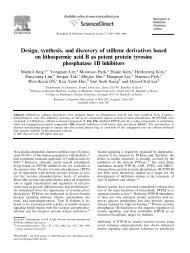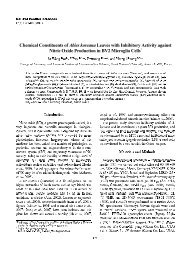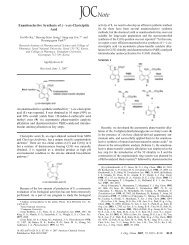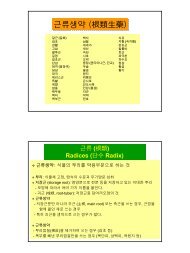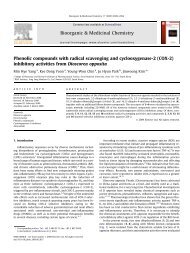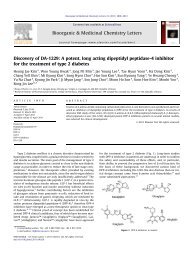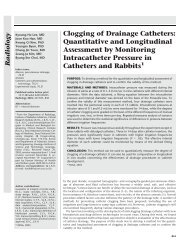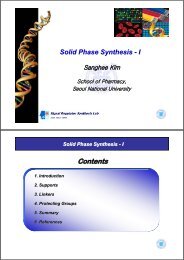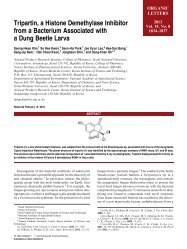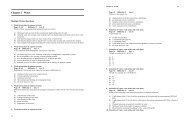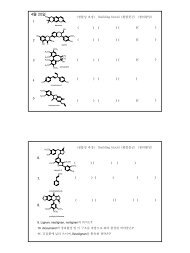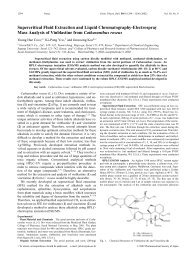Transport of anti-allergic drugs across the passage cultured human ...
Transport of anti-allergic drugs across the passage cultured human ...
Transport of anti-allergic drugs across the passage cultured human ...
You also want an ePaper? Increase the reach of your titles
YUMPU automatically turns print PDFs into web optimized ePapers that Google loves.
208 H. Lin et al. / European Journal <strong>of</strong> Pharmaceutical Sciences 26 (2005) 203–210In order to investigate <strong>the</strong> influence <strong>of</strong> lipophilicity ondrug permeation <strong>across</strong> <strong>the</strong> <strong>passage</strong>d <strong>human</strong> nasal epi<strong>the</strong>lialcell monolayers, a series <strong>of</strong> <strong>anti</strong>-<strong>allergic</strong> <strong>drugs</strong> withvarious 1-octanol/H 2 O partition coefficient (log P) wereselected as model <strong>drugs</strong>. Their log P values and solubilityin transport medium at room temperature are listed inTable 1. The permeation pr<strong>of</strong>iles <strong>of</strong> model <strong>drugs</strong> are shownin Fig. 3. Interestingly, <strong>the</strong> P app values <strong>of</strong> <strong>the</strong> most hydrophiliccompound studied, albuterol hemisulfate (log P = −1.58;P app 0.20 × 10 −6 cm/s), was close to that <strong>of</strong> a paracellularmarker mannitol (log P = −3.10; P app , 0.16 × 10 −6 cm/s).Highly lipophilic budesonide showed <strong>the</strong> P app value <strong>of</strong> 21.92(±0.78) × 10 −6 cm/s. Within <strong>the</strong> log P range from −1.58to 3.21, <strong>the</strong>re was a 100-fold difference in <strong>the</strong> P app . TheP app value significantly increased with <strong>the</strong> enhancement <strong>of</strong>lipophilicity, which indicated that log P is <strong>the</strong> most importantfactor affecting <strong>the</strong> permeability <strong>of</strong> nasal transepi<strong>the</strong>lialroute.Various <strong>anti</strong>-<strong>allergic</strong> <strong>drugs</strong> have been usually selected asmodel <strong>drugs</strong> to study <strong>the</strong> effect <strong>of</strong> lipophilicity on <strong>the</strong> transepi<strong>the</strong>lial(e.g., conjunctival and alveolar) permeability due to<strong>the</strong>ir wide distribution in log P value. However, <strong>the</strong>re has beenno report on <strong>the</strong> transport <strong>of</strong> <strong>the</strong>se <strong>drugs</strong> <strong>across</strong> <strong>the</strong> nasalcell monolayers or animal excised tissue, thus, it was notpossible to estimate <strong>the</strong> intrinsic nasal epi<strong>the</strong>lial cells permeability<strong>of</strong> <strong>the</strong>se <strong>drugs</strong> in vivo. It was exciting though t<strong>of</strong>ind a good log-linear relationship between <strong>the</strong> lipophilicity(log P) <strong>of</strong> <strong>anti</strong>-<strong>allergic</strong> <strong>drugs</strong> and <strong>the</strong> permeability coefficient(P app ) <strong>across</strong> <strong>the</strong> nasal epi<strong>the</strong>lial monolayers (r 2 = 0.92, A–Bdirection; r 2 = 0.94, B–A direction), as shown in Fig. 4 andTable 2. A sigmoid relationship was previously reported in<strong>the</strong> transport studies <strong>of</strong> -blockers <strong>across</strong> <strong>the</strong> primary conjunctivaland <strong>the</strong> alveolar epi<strong>the</strong>lial cell monolayers (Yang etal., 2000; Saha et al., 1994). This sigmoid relationship wasFig. 4. Relationship between P app and log P in different directions <strong>across</strong><strong>passage</strong>d <strong>human</strong> nasal cell monolayers: (1) albuterol hemisulfate; (2)albuterol; (3) fex<strong>of</strong>enadine HCl; (4) dexamethasone; (5) triamcinolone acetonide;(6) budesonide; (a) mannitol; (b) melagatran; (c) sumatriptan; (d)propranolol; (e) nicotine; (f) lidocaine; (g) testosterone; (○) <strong>human</strong> nasalepi<strong>the</strong>lial monolayer, apical to basolateral; () porcine nasal mucosa (Ussingchamber) (Osth et al., 2002; Wadell et al., 2003).also reported in <strong>the</strong> permeability studies <strong>of</strong> -blockers <strong>across</strong><strong>the</strong> excised rabbit conjunctiva and cornea (Wang et al., 1991),and in <strong>the</strong> studies <strong>of</strong> barbiturates <strong>across</strong> <strong>the</strong> excised rat nasalmucosa (Huang et al., 1985).In order to demonstrate <strong>the</strong> feasibility <strong>of</strong> <strong>the</strong> <strong>passage</strong> <strong>cultured</strong><strong>human</strong> nasal cell monolayer model in estimating <strong>the</strong>“intrinsic” nasal permeability <strong>of</strong> <strong>drugs</strong>, <strong>the</strong> P app <strong>of</strong> model <strong>anti</strong><strong>allergic</strong><strong>drugs</strong> need to be compared with that <strong>across</strong> <strong>the</strong> <strong>human</strong>nasal mucosa in vivo. However, since <strong>the</strong>re was no report on<strong>the</strong> nasal transport <strong>of</strong> <strong>the</strong>se in <strong>human</strong>, <strong>the</strong> P app values <strong>of</strong> variouscompounds in <strong>the</strong> literatures <strong>across</strong> <strong>the</strong> excised porcinenasal mucosa were compared with <strong>the</strong> results <strong>of</strong> this study. Asshown in Fig. 4, a similar log-linear relationship was reportedin transport studies <strong>of</strong> various compounds <strong>across</strong> <strong>the</strong> excisedporcine nasal mucosa (r 2 = 0.81, when lidocaine was deleted)(Osth et al., 2002; Wadell et al., 2003). The P app values <strong>of</strong> <strong>anti</strong><strong>allergic</strong><strong>drugs</strong> <strong>across</strong> <strong>the</strong> <strong>passage</strong> <strong>cultured</strong> <strong>human</strong> nasal cellmonolayer were significantly lower than those various compounds<strong>across</strong> <strong>the</strong> excised porcine nasal mucosa. For example,<strong>the</strong> P app values <strong>of</strong> mannitol <strong>across</strong> <strong>the</strong> <strong>passage</strong> <strong>cultured</strong><strong>human</strong> nasal cell monolayer was 0.90 ± 0.30 × 10 −6 cm/sFig. 3. <strong>Transport</strong> pr<strong>of</strong>iles <strong>of</strong> all <strong>the</strong> model <strong>drugs</strong> <strong>across</strong> <strong>the</strong> <strong>passage</strong>d <strong>cultured</strong><strong>human</strong> nasal cell monolayers with TEER value higher than 800 cm 2 usingLCC culture method. Each point represents <strong>the</strong> mean ± S.D.; n ≥ 3 experiments;() albuterol hemisulfate, 500 g/mL; (□) albuterol, 500 g/mL;() fex<strong>of</strong>enadine HCl, 500 g/mL; () dexamethasone, 50 g/mL; (△) triamcinoloneacetonide, 20 g/mL; (♦) budesonide, 15 g/mL.Table 2Permeability coefficient <strong>of</strong> model <strong>drugs</strong> in <strong>the</strong> direction <strong>of</strong> apical to basolateroland reverse direction <strong>across</strong> <strong>passage</strong>d <strong>human</strong> nasal epi<strong>the</strong>lial monolayers(mean ± S.D., n >3)Model drugConcentrated(g/mL)P app (A–B)(10 −6 cm/s)P app (B–A)(10 −6 cm/s)Albuterol hemisulfate 500 0.20 ± 0.02 0.23 ± 0.05Albuterol 500 0.78 ± 0.23 0.61 ± 0.04Fex<strong>of</strong>enadine HCl 500 0.54 ± 0.12 0.60 ± 0.16Dexamethasone 50 4.88 ± 0.30 4.10 ± 0.64Triamcinolone acetonide 20 10.31 ± 0.25 10.90 ± 0.58Budesonide 15 21.92 ± 0.78 19.81 ± 1.39



